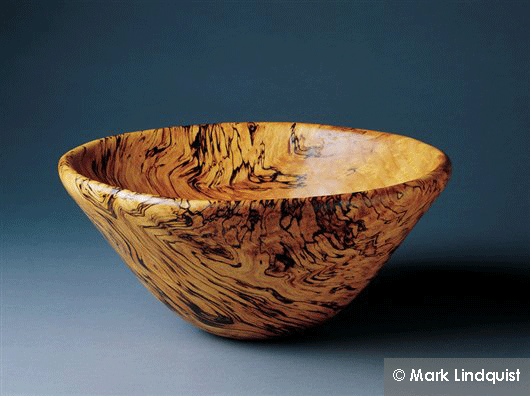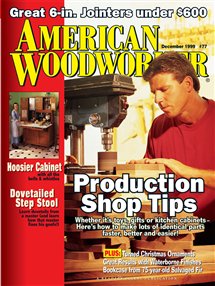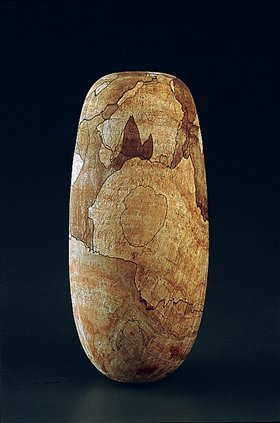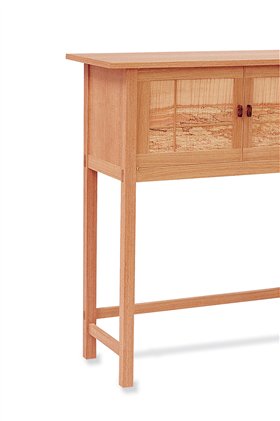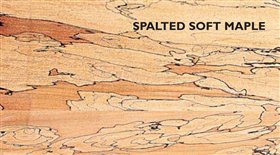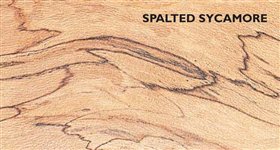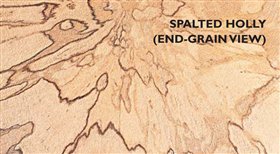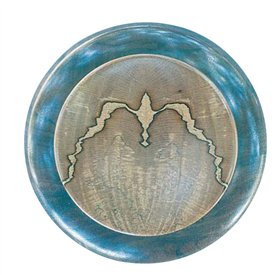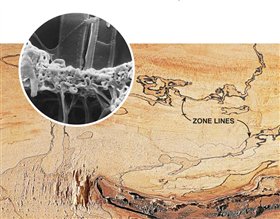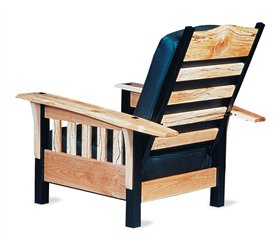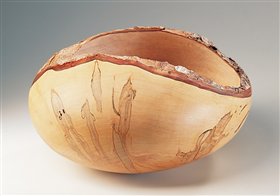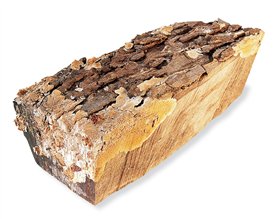When wood is captured somewhere between the extremes
of being completely sound and fully rotten, it can display
magnificent beauty. The discoloration, prominent
black lines and changes in texture that occur
during the decaying process are known to
woodworkers as spalting.Spalting is a by-product of the rotting
process that is carried out by a vast
army of stain, mold and decay fungi.
They are abundantly present in the air
and soil, waiting for favorable conditions
and a suitable host. Generally, wood moisture
content of at least 25 percent, temperatures from about 40-
to 90-degrees F, air and food (especially abundant in sap wood)
are what the fungi need. A tree or branch freshly fallen onto a
damp forest floor in warm weather is asking for it.Lighter colored woods offer the best canvas for nature’s
graphic work. Hard maple is viewed as the king of spalted
woods, although sycamore, persimmon, red and white oak, elm,
pecan, birch, buckeye, apple, magnolia, beech, holly, hackberry,
box elder and the sapwoods of walnut and cocobolo are favored
by woodworkers as well.
Where to find spalted wood
You can purchase spalted wood—usually
maple—from specialty lumber and
mail order suppliers (see Sources, below). Turning blocks are most easily
found, but a few suppliers offer boards
when they can get them.
Hunting spalted wood is like panning
for gold—lots of searching for
that one precious nugget. Logs rotting
on the forest floor, dead limbs and
entire dead standing trees are excellent
sources. You can also hunt for hidden
treasure at a community bone yard
of removed trees, and don’t overlook
the bottom of your old firewood pile.
Make your own spalted wood
Woodworkers commonly use these
methods to cause wood to spalt. They
will work most effectively if the temperature
is kept where the fungi will
thrive, between 60- and 80-degrees F.
Monitor the spalting progress
monthly—the optimal conditions
you’ve created can make it happen fast.
• Place a freshly cut log section 2 to 3
ft. long upright on the bare ground.
Put a shovel of dirt on the top end and
cover it loosely with black plastic.
• Bury a log, freshly sawn green boards or
green rough-turned bowls in damp sawdust
containing pieces of rotten wood
with active fungi. Keep the sawdust moist.
• Use plastic bags or plastic garbage
cans to hold short sections of green
wood or rough-turned bowls. Adding
some soil or rotting sawdust may speed
the process, although the fungi already
present in the air or on the wood surface
is probably enough to get it going.
Leave the bags or cans with a small
opening to allow for some air exchange.
How to stabilize spalted wood
Remove those things the fungi need
to grow, and you’ll stop its progress.
One method is to lower the wood’s
moisture content.Wood below 25-percent
moisture content, when kept in
low relative humidity, is not likely to
decay or even stain. Accomplish this by
air or kiln drying, placing smaller pieces
in a microwave or finish turning if the
piece was a rough-turned bowl. You
can also raise or lower the wood’s
temperature. Spalting rarely occurs
above 90-degrees F and stops below
32-degrees F. Some turners store blanks
in a freezer prior to finish turning.
Finally, you can restrict the air—no
air, no decay. Logs submerged in water,
for example, do not decompose from
fungi. Tightly wrapping the wood in
several layers of plastic will restrict the
air and slow the growth of the fungi.
Working properties
If you’re lucky, you’ll catch the spalting
at the right time, before the cellular
structure of the wood deteriorates,
and you’ll be able to work the piece
without any trouble. Sometimes, however,
the material will have areas that
have become soft and punky. These
areas have no strength and defy normal
woodworking strategies. They will
crumble, tear out in chunks or leave a
wrinkled appearance when you try to
cut or plane them. They refuse to be
glued together, and leave you with a
cratered, uneven surface when you
try to sand. Though
not suitable for joinery, these soft areas can often be
stiffened enough to finish so the piece
of wood can still be used decoratively.
You can saturate soft areas with a
liquid hardener. Where the wood is
only marginally soft, a spot coat or
two of clear shellac or nitrocellulose
sanding sealer may harden it sufficiently.
A really punky spot will
require cyanoacrylate (CA) glue (the
thin, watery type) or a product made
to stabilize rotten wood. There are a
number of them sold as wood hardeners
at hardware stores. It may take several generous applications to treat
each bad spot. These hardeners are
effective, but they have side effects.
They fill the wood cells, so surfaces
treated with them can’t be glued and oil
finishes don’t take well because they
can’t penetrate. Solvent-based hardeners
and CA glues darken the wood
considerably. I like Protective Coatings
Petrifier (see Sources, below). It’s a
water-based hardener that doesn’t discolor
the wood, yet seals and stiffens
effectively. It’s an excellent choice for
troublesome soft spots.
You should be able to work the stiffened
surface with edge tools—make
very light cuts—or with abrasives, taking
care to provide
a firm, flat
backing for the
sandpaper. Some
turners use body
grinders or stiffbacked
sanding
discs and work
the piece while
it’s spinning on
the lathe. For
flat lumber, an
abrasive planer
is an excellent
option, followed
by a randomorbit
or pad
sander. If you
sand by hand,
use a sanding
block to give
firm support to
the paper.
Finishing
You are likely to encounter three problems
when you finish spalted wood:
Splotching, yellowing and excessive
darkening. The whiter woods—which
usually have the most dramatic examples
of spalting—can turn quite yellow with
certain finishes, and because the soft
areas act like end-grain or even a sponge,
splotching or excessive darkening can
result unless the piece is sealed first.
An effective weapon against splotching
is clear, dewaxed shellac used as a
sealer. (Spray cans of shellac are thinned
and dewaxed.) Cover the entire piece
with a thin coat and let it dry. Then
recoat dull-looking areas until all surfaces
have a uniform sheen. You can use
almost any finish as a topcoat over
dewaxed shellac
after it’s been
sanded.
To minimize yellowing and darkening, use a surfacefilm
finish like clear shellac or lacquer. Waterborne
finishes dry clear and don’t yellow with age. If the
piece is primarily decorative and has few, if any, soft
areas, clear wax is appropriate.
If you don’t mind the yellowing and darkening, use
your favorite oil finish, but be prepared to make many
applications to the softer areas. Experience has taught
me that an oil-finished spalted piece will appear rather
muddy and uneven at first, but will look better as the
finish cures, which can take weeks or even months.
Some oil finishes (such as General Finishes Sealacell
Step 1, see Sources, below) are essentially a thinned,
light-colored varnish, and will not yellow as much.
If you are looking for a challenge, and effects that
often surpass the wildest woods from the tropics,
spalted wood may be your ticket. Each block of wood
has its own unique properties that must be judged and
worked on its own terms. Use spalted wood and your
work will never go unnoticed. Use it well, and you’ll produce
a real showstopper.
Sources
(Note: Product availability and costs are subject to change since original publication date.)
Flat material suppliers:
Northwest Timber
P.O. Box 1010
Jefferson, OR 97352
541-327-1000
Randel Woods
P.O. Box 96
Randel,WA 98377
360-497-2071
Talarico Hardwoods
RD #3 Box 3268
Mohnton, PA 19540-9339
610-775-0400
Bigleaf Maple:
Mount. Cheam Woodworking
8359 Banford Road
Chilliwack, B.C.V20GH3
604-795-9297
Turning stock suppliers:
One Good Turn
6064 S. 300 W. #11
Murray, UT 84107
801-266-1578
Choice Woods
833 W. Main St.
Louisville, KY 40202
888-895-7779
Craft Supplies USA
1287 E. 1120 S.
Provo, UT 84606
800-551-8876
Hot Stuff CA Glue
Satellite City, P.O. Box 836
Simi Valley, CA 93062
800-786-0062
P. C. Petrifier
Protective Coatings
221 S. 3rd St.
Allentown, PA 18102
800-220-2103
General Finishes
Sealacell Step 1
P.O. Box 51567
New Berlin,WI 53151
800-888-8286
For further reading:
“Sculpting Wood” by Mark
Lindquist, 1986, Worcester, Mass., Davis Publications, 800-533-2847. Mark and his father Mel have been pioneers in working spalted wood and in popularizing its use as a decorative material.
“Understanding Wood” by Bruce Hoadley, 1980, Newtown, Conn., Taunton Press, 800-888-8286.
This story originally appeared in American Woodworker December 1999, issue #77.

Purchase this back issue. |
|
Click any image to view a larger version.


Cabinet on Stand
English oak with spalted bigleaf
maple panels
by Tim Patterson, student,
College of the Redwoods, 1996.




Claro walnut box inlaid with spalted end-grain sycamore,
bookmatched to form a bird image by Del Stubbs, 1982.

An active fungus colony surrounds itself with a chemical and
physical barrier that defines its outer boundaries. Filaments of the
fungus pack and swell in these regions and exude generous
amounts of pigmented material that usually appear as black lines.
The material in these “zone lines” protects the colony from attack
by bacteria, insects, and other fungi, and assists in maintaining a
desirably moist atmosphere. Inset: Electron microscope view of a
fungus zone line in front of wood cell structures.


Worm-spalted
red maple bowl
by Alan Lacer, 1998. Typical spalting differs from
worm spalt, where the worm
hole allows the fungus to enter
and work from the inside out.
Working Spalted
Wood Safely

There is anecdotal and some medical
evidence that substances from
decaying wood are a health threat.
Allergic reactions and some serious
lung diseases have been traced to spores
and fungi that inhabit rotting wood. The
effect on an individual woodworker depends on
his or her tolerance to the spores and fungi, the concentration
of them in the environment and the length of
exposure. Persons with weakened immune systems, lung illnesses
or who show signs of allergic reactions to the spalted wood
should avoid the material altogether. One must err on the side of
caution when working spalted wood. Freshly sawn green material
with active spores and fungi, or even air-dried material, is potentially
the most hazardous. Kiln drying, by turning up the heat and
driving out the moisture, will actually kill both fungi and spores.
To avoid breathing spalted wood
dust, I strongly recommend that
you wear a respirator—not a
nuisance mask—and have an
effective point-of-origin dust collection
system or a self-contained
air filtration helmet. Avoid
prolonged contact with your
skin, and clean your work area
thoroughly following any work
with spalted wood. |
